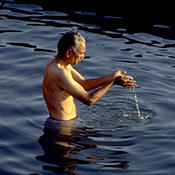 The Hindu tradition reflects the interweaving of Harappan, Aryan, Dravidian, and tribal cultures across the many regions of India.
The Hindu tradition reflects the interweaving of Harappan, Aryan, Dravidian, and tribal cultures across the many regions of India.
View full album
What has come to be called the “Hindu” tradition is a rich fabric of civilization, including many hues and textures of religious life. It is woven of the religious cultures and ways of many peoples, speaking many languages, and worshipping through many images of the Divine.
The oldest culture of South Asia was that of the Indus River Valley where cities flourished for perhaps a thousand years, from about 2500 to 1500 BCE. The remains of their finely planned cities, Mohenjo Daro and Harappa, give clues to the ritual life of what was once a widespread civilization. For example, a large rectangular ceremonial pool suggests the temple tanks and the practice of ritual bathing that are still important to the Hindu tradition.
The Aryan peoples began to move into northwest India from Central Asia about 1500 BCE, eventually settling in the wide plains of the Ganges River. Their legacy includes the Sanskrit language and a large corpus of religious hymns and poems called the Vedas. Vedic ritual life focused around the fire altar, with rites of offerings to the gods for well-being. Their four classes—priests, kings, merchants, and servants—became the basis of India’s social system of castes.
The Aryans did not, however, erase the Harappan culture or the indigenous civilizations of ancient India speculatively identified with the Dravidian cultures and language groups of south India. Nor did Aryan culture eradicate the many tribal traditions of India. The interrelations and interweaving of Aryan, Dravidian, and tribal cultures have created the dynamic process called the “Hindu tradition”. The reformulation of the tradition has continued through the centuries, and it continues today as Hindus in the cities of modern India reshape traditions in the context of industrial, urban culture.
The Hindu tradition also reflects the diversity of India’s distinctive regional cultures, each with its own language and traditions. One broad grouping of languages is of Indo-European origin, related to the classical Sanskrit of the Aryans. Its modern vernacular derivatives include Bengali in the northeast, Punjabi in the northwest, Oriya on the east coast, Marathi and Gujarati on the west coast, and Hindi across the heartland of north and central India. These languages are closer in structure to their cousin, English, than to the Dravidian languages of south India: Telugu, Tamil, Kannada, and Malayalam.
People speaking, singing, and writing all these regional languages have made their own distinctive contributions to the texture and color of the Hindu fabric. In the 20th and 21st centuries, these regional religious traditions have been traveling with Hindu immigrants to America.